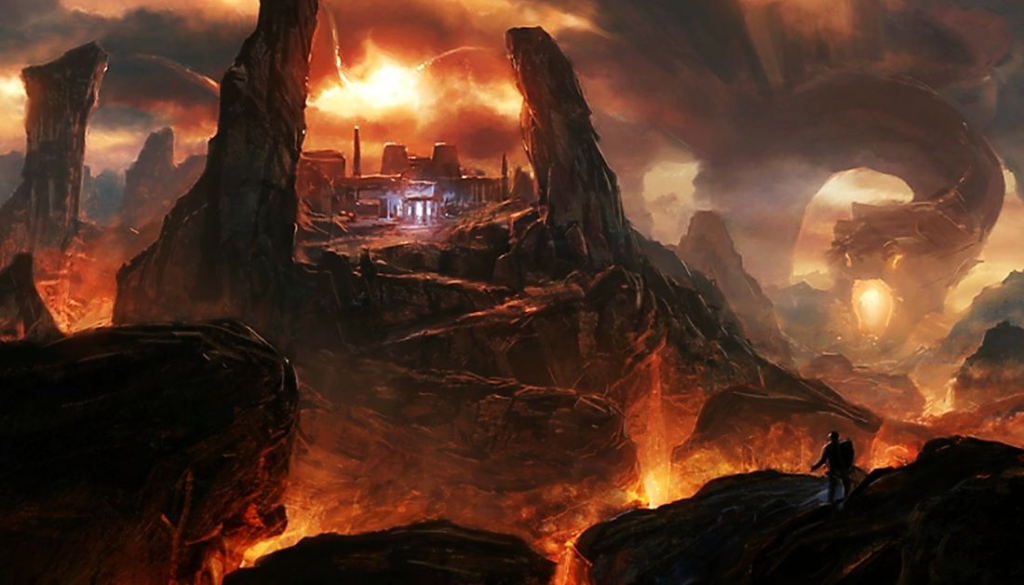Tartarus, in Greek mythology, is not merely a place but a concept embodying the most profound depths of the underworld. It stands as a chilling counterpoint to Elysium, the blissful realm of the blessed. While Elysium offered eternal joy, Tartarus was reserved for the most heinous of criminals, a place of eternal torment and suffering.
A Descent into Darkness
Location: Geographically, Tartarus was often depicted as situated beneath the earth, deeper even than Hades, the realm of the dead. It was a place of utter darkness, where even the gods feared to tread.
Inhabitants: Tartarus was the abode of monstrous beings, including the Titans, primordial giants who were overthrown by the Olympian gods. Other inhabitants included the Furies (Erinyes), vengeful spirits who pursued those guilty of crimes against family or kin, and the Gorgon Medusa.
Punishments: The punishments inflicted upon those condemned to Tartarus were truly horrific. Some sources mention:
Endless Chains: Criminals were often bound with unbreakable chains, suffering eternal imprisonment.
Rivers of Fire: Some were plunged into rivers of fire, enduring unimaginable agony.
Eternal Torment: Others faced constant torment from monstrous creatures or were subjected to other horrific punishments tailored to their crimes.
Myths and Legends
The Titans: The most famous inhabitants of Tartarus were the Titans, led by Cronus. After their defeat by the Olympian gods, they were imprisoned within Tartarus, a testament to the gods’ power and the ultimate price of rebellion.
The Fall of Icarus: While not directly related to Tartarus, the myth of Icarus serves as a cautionary tale about the dangers of hubris. Icarus, warned against flying too close to the sun, disobeyed his father Daedalus and plummeted to his death in the sea, a fate often associated with the fall into the abyss.
Tartarus in Modern Culture
Literature: Tartarus has continued to inspire writers and artists throughout the ages. It appears in numerous works of literature, from ancient Greek tragedies to modern fantasy novels.
Art: Depictions of Tartarus vary widely in art. From ancient Greek vase paintings to modern interpretations, artists have explored the concept of the abyss and the horrors that reside within.
Tartarus in Literature and Culture
The image of Tartarus has continued to haunt the human imagination for centuries. It has been a recurring motif in literature, art, and religion, serving as a powerful symbol of fear, despair, and the ultimate consequences of evil.
Dante’s Inferno: Dante Alighieri’s epic poem The Divine Comedy draws heavily on the imagery of Tartarus. His depiction of the nine circles of Hell, with its escalating levels of torment, echoes the punishments inflicted upon the inhabitants of the Greek abyss.
Modern Literature: Tartarus has also inspired countless works of modern literature, from horror stories to science fiction novels.
It has become a shorthand for any place of unimaginable suffering, whether physical or psychological.

Punishment in Tartarus
Tartarus was not merely a place of imprisonment; it was also a place of eternal torment. The nature of the punishments varied depending on the individual, but they were all designed to inflict maximum suffering. Some of the most common punishments included:
Eternal Chains: Many of Tartarus’s inhabitants were bound by unbreakable chains, preventing any hope of escape. These chains symbolized the absolute power of the gods and the futility of resistance.
Starvation and Thirst: The abyss was a desolate and barren place, offering no sustenance or comfort. Those imprisoned within suffered from constant hunger and thirst, adding to their misery.
Other Horrors: The specific nature of the punishments often reflected the crimes of the individual.
For example, Sisyphus, the cunning king, was condemned to eternally roll a heavy boulder up a hill, only to have it roll back down again. Tantalus, who had revealed the secrets of the gods, was eternally tormented by the sight of food and water that he could never reach.
Tartarus: A Primordial Force
In Greek cosmology, Tartarus was not merely a place but a primordial force, one of the earliest beings to emerge from Chaos. Hesiod’s Theogony describes it as a vast chasm, “as far below the earth as heaven is from the earth.” This immense depth reflects its role as the ultimate place of confinement, a bottomless pit where even the mightiest titans could be imprisoned.
Tartarus was a place of both awe and terror. Its immense depth and darkness symbolized the unknown and the unknowable, the ultimate limit of human experience. It was a place where the laws of nature seemed to break down, where time and space lost their meaning.
Tartarus: A Symbol of the Abyss
The concept of Tartarus transcends simple geography. It serves as a powerful symbol of the human psyche’s darkest depths, of the fear of the unknown, and of the consequences of our actions. Whether it exists literally or metaphorically, Tartarus continues to haunt our imaginations, a reminder of the abyss that lies within us all.
Final Thoughts
Tartarus, the abyss of Greek mythology, remains a potent symbol of the depths of human fear and the ultimate consequences of evil. Its image continues to resonate with us today, reminding us of the importance of justice and the dangers of unchecked ambition. As we confront the challenges of our own time, the lessons of Tartarus offer a timeless warning: even the most powerful among us can fall, and the consequences of our actions can be far-reaching and devastating.
FAQs
What is Tartarus in Greek Mythology?
In Greek mythology, Tartarus is not simply the underworld, but a deeper, more terrifying abyss reserved for the most wicked and the most powerful enemies of the gods. It is a primordial force, a vast chasm that lies far beneath the earth, a place of eternal torment and despair. Tartarus was a place of both awe and terror, symbolizing the unknown and the unknowable, the ultimate limit of human experience.
What is the significance of Tartarus in modern culture?
The concept of Tartarus continues to resonate with us today. It has become a shorthand for any place of unimaginable suffering, whether physical or psychological. It serves as a potent reminder of the importance of justice and the dangers of unchecked ambition.
How does Tartarus differ from Hades?
While both Tartarus and Hades are associated with the underworld, they are distinct concepts. Hades is generally understood as the realm of the dead, a vast and shadowy realm where the souls of the departed reside. Tartarus, on the other hand, is a deeper, more terrifying abyss reserved for the most wicked and the most powerful enemies of the gods.
To read more, Click Here













Leave a Reply